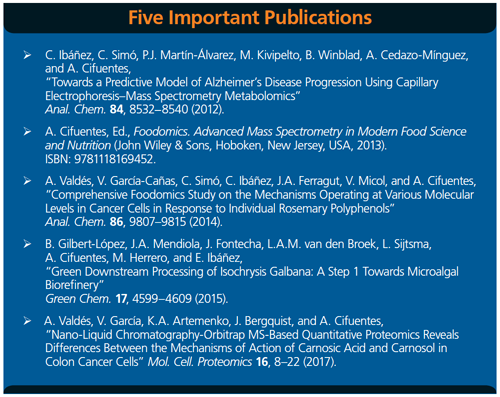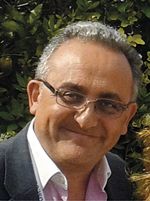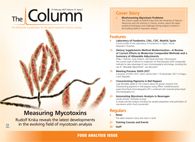Laboratory of Foodomics, CIAL, CSIC, Madrid, Spain
The Column
A brief profile of the Laboratory of Foodomics in Spain, led by Alejandro Cifuentes.
Photo Credit: Courtesy of the Author

A brief profile of the Laboratory of Foodomics in Spain, led by Alejandro Cifuentes.
Name of Research Institute:
Institute of Food Science Research (CIAL), National Research Council of Spain (CSIC)
Name of Laboratory:
Laboratory of Foodomics
Research Leader:
Prof. Alejandro Cifuentes
Number of Staff:
Two professors (A. Cifuentes and E.
Ibáñez), one tenured scientist (M. Herrero),
one higher scientific officer (J.A.
Mendiola), and one technician (C. Cuéllar)
Number of Students:
Three post-docs, four PhD students, two master students, and a variable number of visitors from abroad doing different stays (at this moment we have visitors from Italy, Brazil, Czech Republic, Algeria, Tunisia, Colombia, and Mexico).
Core Analytical Techniques:
The main instruments in our laboratory are focused on green extraction processes and advanced (including massive) analytical techniques. Namely, we have different instruments for SFE, PLE, CE–MS, LC–MS, LC×LC–MS, GC–MS, and RT–PCR that allows us to carry out foodomics analysis, including metabolomics, proteomics, and transcriptomics (plus data integration), as well as extraction and characterization of bioactive food ingredients and natural compounds.
Research Focus:
Our main research focus is to investigate old issues related to food quality, safety, traceability, and bioactivity from a new angle as provided by foodomics. In this line of research, we develop transcriptomics, proteomics, and metabolomics approaches to study how foods (including functional ingredients) interact with our genome and the subsequent modifications that these interactions can generate at proteome and metabolome level. Based on this strategy, we are investigating the antiproliferative activity of food ingredients against colon cancer. In addition, we apply MS-based -omics approaches to investigate non-intended modifications in transgenic foods, and to study issues related to food quality and safety as a whole. Moreover, we develop new environmentally friendly extraction processes (green processes) to discover and to obtain new bioactive compounds from food byproducts and natural sources including algae and microalgae. Last but not least, we develop multidimensional methodologies based on LC×LC–MS/MS to chemically characterize the complex composition of the new natural extracts.
Future Research Projects:
We are now at the beginning of this new road, so, our idea is to continue developing all the necessary tools to successfully address
all the challenges that we will have to face in the near future to investigate food quality, safety, and traceability, and of upmost importance the interaction between food and health.
Future Direction of Group:
We are now working on a new project proposal on the interaction between food bioactives and neurodegenerative diseases.
Partnering Organizations:
We have many collaborations with other laboratories from Spain and abroad. For instance, in the last five years we have published papers with groups from: Karolinska Institute; University of Bologna; University of California Davis; University of Catania; University of Salerno; University of Aveiro; CNR; Academy of Sciences of the Czech Republic; University of Sao Paulo; University of Messina; Wageningen UR Food & Biobased Research; University of Lund; University Católica of Chile; Kaunas University; Miguel Hernandez University; University of Valladolid; University of Alcala de Henares; University of Granada; University Autonoma of Madrid; Institute of Science and Technology of Polymers (CSIC); CIB (CSIC); Universidad de las Palmas de Gran Canaria; University of Oviedo; University of La Laguna; and University of Jaen.



TEAM LEADER
Prof. Dr. Alejandro Cifuentes, Laboratory of Foodomics, CIAL
What is your role at the Laboratory of Foodomics?
I am the head of the laboratory, so, my role is basically to propose the research lines to follow, to integrate the multidisciplinary work done at the lab, to give it visibility, and to find the necessary resources for the group. Moreover, with a relatively large group of people, it is important to lead all of them towards the same goal while, at the same time, promoting independent thinking and initiative. This point is one of the most challenging parts of my work and what really makes the difference; I believe this is why our group is currently leading this field.
What are you currently working on?
The study of the binomial food and health through the development of advanced foodomics strategies.
What have you found that has surprised you?
In recent years we have been able to develop and incorporate into our laboratory all the necessary know-how to carry out transcriptomics, proteomics, and metabolomics analysis, and, what is even more important and complex, to integrate the huge amount of data that we are now able to generate with these -omics tools in a foodomics approach. There are many challenges that still have to be faced to completely understand the complex influence of food on our health, or the everyday more intricate questions related to ensure food quality, safety, and traceability in the current global market. We believe that foodomics can play a crucial role for adequately answering these issues. Moreover, one unique aspect of our group is the capability for developing and integrating new green processes to get valuable extracts from different raw materials that, in the end, can increase the viability and economic interest of the whole study. Other important issues, such as a sustainable development, are also included in our goals - in this way we can face the requirements for a new “green food era”.
E-mail:a.cifuentes@csic.esWebsite: www.cial.uam-csic.es/pagperso/foodomics/a_cifuentes.html

RESEARCHER
Prof. Dr. Elena Ibáñez, Laboratory of Foodomics, CIAL, CSIC
What research project are you working on now and why?
I am working on a European Project called Miracles (“Multi-product Integrated bioRefinery of Algae: from Carbon dioxide and Light Energy to high-value Specialties”). In this project our main goal is to develop integrated biorefinery and processing technologies employing green extraction techniques to produce multiple specialty products from microalgae biomass with the idea of valorizing all biomass components. This is a research line of high interest at the Foodomics Laboratory since we provide the natural extracts from different natural sources that will be tested and evaluated using a foodomics approach. These first steps in the workflow of our laboratory should comply with green chemistry principles. Moreover, we also work on the chemical and functional characterization of the extracts using advanced analytical techniques and in vitro assays, so, we assist with the filtering and selection of the most promising extracts.
What analytical challenges have you overcome?
Most of our processes are first developed at small (analytical) scale; this allows us to perform all the experiments at minimum costs and to test different ideas and designs that can be translated to pilot scale. This is a challenge because, as mentioned, we try to comply with green chemistry principles and, therefore, we are always seeking green alternatives, not only to the processes, but also related to the analytical chemistry developments in our work. This is a challenge that remains: to be able to work under the guidelines of green chemistry and green analytical chemistry (GAC) (and to be able to measure it and to compare our methods and processes with other classical alternatives).
What have you found that has surprised you?
I am surprised by the “still” low level of implementation of the GAC principles in the laboratories. This is an aspect that should be improved since it has many implications for the environment, health, and costs and in most laboratories these aspects are underestimated; people prefer to be using the same protocols and methods than to invest time and resources to make them greener.
E-mail:elena@ifi.csic.esWebsite:www.cial.uam-csic.es/pagperso/foodomics/elena_ingles.html

Analytical Challenges in Measuring Migration from Food Contact Materials
November 2nd 2015Food contact materials contain low molecular weight additives and processing aids which can migrate into foods leading to trace levels of contamination. Food safety is ensured through regulations, comprising compositional controls and migration limits, which present a significant analytical challenge to the food industry to ensure compliance and demonstrate due diligence. Of the various analytical approaches, LC-MS/MS has proved to be an essential tool in monitoring migration of target compounds into foods, and more sophisticated approaches such as LC-high resolution MS (Orbitrap) are being increasingly used for untargeted analysis to monitor non-intentionally added substances. This podcast will provide an overview to this area, illustrated with various applications showing current approaches being employed.
Investigating PFAS in Plastic Food Storage Bags Using LC–MS/MS
May 8th 2024Yelena Sapozhnikova from the United States Department of Agriculture spoke to The Column about her innovative research investigating PFAS in plastic food storage bags using targeted and non-targeted liquid chromatography–tandem mass spectrometry.